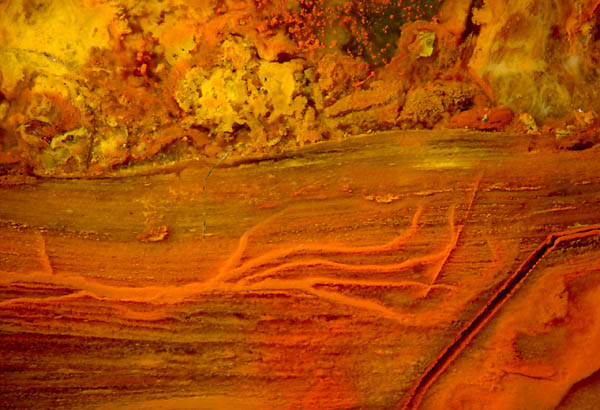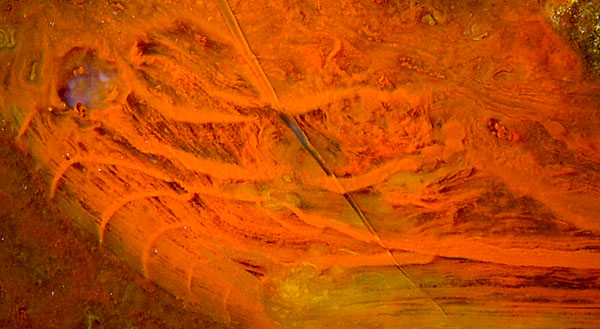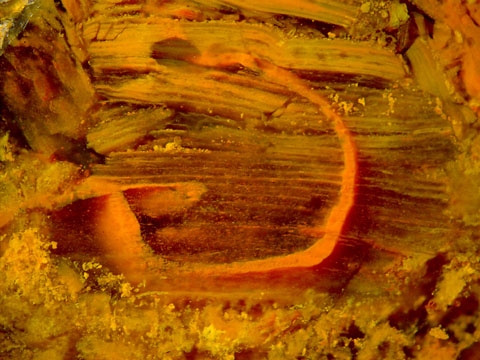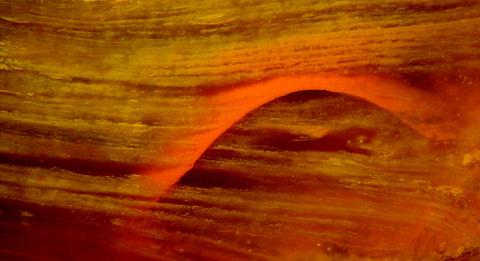Eerie shapes athwart microbial layer stacks

The colour of the red and yellow chert varieties from the
Döhlen basin
(Lower Permian) in Saxony is due to the oxygen production of blue-green
algae and subsequent precipitation of iron oxides. Depending on the
growth mode of the algae, the stain appears as clouds or as
stacks of
thin layers. Most often everything looks normal but there are rare
cases of unexplained phenomena as in Fig.1 where a red hand with five
fingers does not only make an eerie sight but also seems to defy any
attempt at an explanation. The fingers are certainly not brought about
by disintegration of the layer stack while still
in a fluid state, as observed occasionally.
(See Permian Chert News 8.)
Fig.1: Mysterious finger-like structure penetrating a stack
of thin
microbial layers, picture
width 7mm.
The crack on the right
went straight through the
stack as if it were an isotropic material until its tip reached a
position where the
mechanical anisotropy of the stack was dominating so that fracture
mechanics caused the crack to make a sudden kink. Later on, the crack
got a thin red lining and a fill of clear chalzedony which appears dark
now. This crack is not helpful in connection with the mysterious
structure.

Fig.2 (left): Similar as Fig.1, evenly spaced "claws" seen as if
grabbing a bent stack of layers. Picture
width 7mm, (same scale for all pictures).
Fig.2
provides additional information. The path of the long crack in the
middle, ending below, had not been influenced by the presence of
layers, hence it must have propagated at an advanced stage of
silicification when the silica gel had become rather stiff. Later the
crack healed by getting filled with clear silica gel turning into
chalzedony, hence the dark
aspect. By that time, the mysterious sructure had not yet been there
since it had not got split by the crack. It cannot be
explained as late cracks filled with red substance since there are no
displacements associated with wide cracks.
Fig.3 (right): Mysterious thick-walled bowl, unaffected by the
microbial layers, with 3D-aspect.
Picture width 5.5mm.

Not
only branching structures as in Figs.1,2 but also simple ones as in
Figs.3,4 may give
rise to awe and wonder as they make an otherworldly sight. In Fig.3,
"this world" is made up of the usual yellow-stained microbial
formationes in clear chalcedony, floccules
below and sheets in stacks seen as parallel lines in cross-section,
partially crushed at some stage of silicification, while a bowl-shaped
body seems to float there ghost-like, penetrating everything. Part of
its wall is seen extending into the depth, which provides a 3D-aspect.
Fig.4 (left): Thin red shell among yellow-stained
microbial layers in clear chalcedony,
with 3D-aspect. Picture
width 5.5mm.
Unlike
the red formations in the above images, the shell in Fig.4 is thin,
30-50µm (not
seen with this illumination). The edge seen here is not a cut edge all
along. There is a definite natural edge of the
shell, seen here only below
left where it dives down behind microbial layers. The visual
3D-impression is enhanced by several stained layers in
clear chalcedony on the left touching
the red shell behind.
The
enigmatic structures of the types shown here seem to be rare phenomena
in the Permian cherts from Saxony.
Only a few more have been observed and recorded, and not much can be
said about their possible way of formation. Apparently, oxygen and
dissolved iron had moved through the solid silica gel by diffusion.
Their precipitation as red
hematite in definite sheets, thick or thin, branching or not, athwart
existing
structures, must remain enigmatic here.
Samples: Old
fragments of chert layers found in glazial river deposits at Hänichen
and Wilmsdorf, Döhlen basin, Freital near Dresden, Saxony.
Labels: H/248.2 (1.8kg, 1999), H/375.1 (12kg, 1999), W/8.2
(1.1kg, 1992 ?), H/333.1 (4.65kg, 2001). The
weight refers to the undivided samples.
H.-J.
Weiss 2018
|
 |
 18 18 |
refersto

 18
18




 18
18